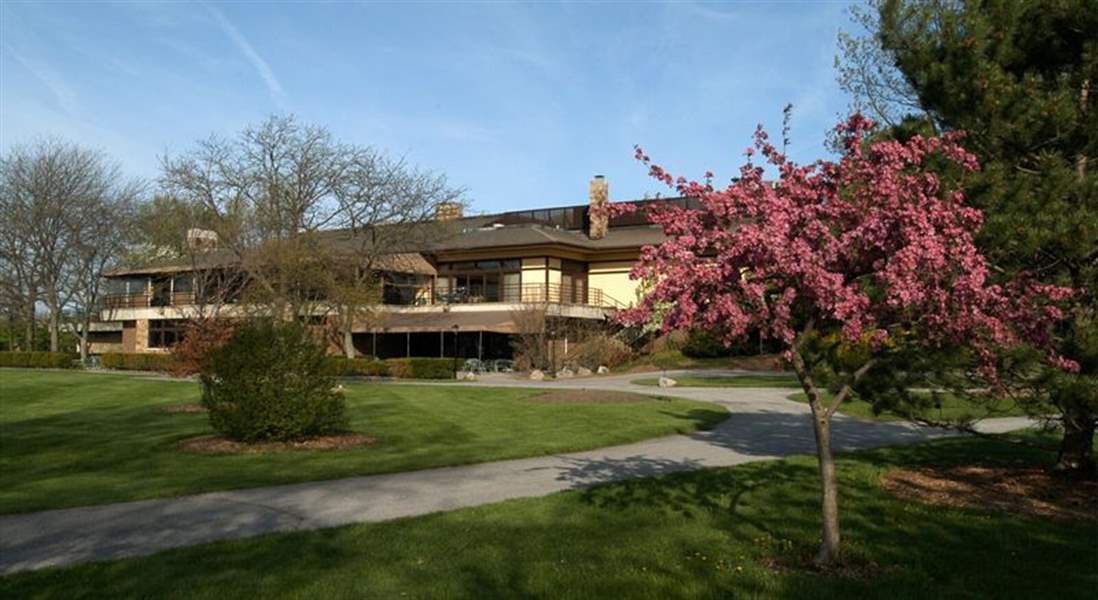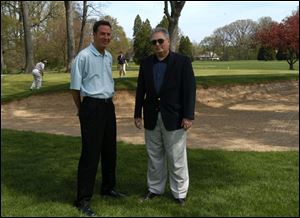
Private clubs going extra yard for members
5/14/2004
Belmont Country Club, which lowered initiation fees several years ago, has renovated every room of its clubhouse recently and is spending six figures-plus on improving the golf course and equipment.
Simmons / Blade
Dan Hathaway, the general manager at Heather Downs Country Club, knows how Mark Twain must have felt when Twain read his own obituary.
Hathaway feels, not unlike Twain, that the reports of Heather Downs demise have been greatly exaggerated.
“Like any other private club, we ve suffered a loss of members due to the economy,” Hathaway said. “Club membership is a discretionary spending item being cut from a lot of personal budgets. But the word on the streets that had us about to go under is very much an exaggeration.”
Still, there is no question these are challenging times for private country clubs - there are eight in the immediate Toledo area and a total of 21 in northwest Ohio and southeast Michigan that belong to the Toledo District Golf Association.
As Hathaway mentioned, an at-best sluggish economy is cited as the main culprit. Other factors in membership decreases include a stagnant population base that makes it more difficult to deal with member attrition, and the competition of affordable, yet upscale daily-fee courses that offer country club-like conditions and services.

Head pro Mike Stone, left, and general manager Dan Hathaway are confident Heather Downs is recovering.
Waiting lists, a staple for many years at places like Inverness Club and Belmont, are a thing of the past. Now it s survival of the fittest.
The country club business centers around golf, although other sports facilities - swimming pools, tennis courts, etc. - and social aspects all figure into the membership equation.
But it is the golf course that gives each club its personality and identity. Take away golf and there would be little to distinguish among them.
Legendary architect Donald Ross and one-time British Open champion Willie Park Jr. didn t design clubhouses or diving wells. They designed golf courses, including those at Inverness and Sylvania Country Club, respectively. They are, arguably, the best in town. Belmont is probably the toughest. Highland Meadows, which annually hosts an LPGA tournament, is by reputation the sportiest. Toledo Country Club is the oldest, and finishes with three holes along the Maumee River that are a special treat.
Every club stakes a claim to golf fame, because the course sells. But the country club business is as much about green as greens, and today s economic challenges have created a bunker mentality that has nothing to do with sand.
“Every club in town, I suspect, has put together incentive packages of some type to get new members,” said Mike Searle, the general manager at Highland Meadows Golf Club in Sylvania. “Toledo is not a hotbed of population growth, and only a certain percentage of the population has an interest, or can afford an interest, in belonging to a private club. So we re all targeting the same people. In some fashion we re trading members.”
Those incentive packages come in the forms of reduced initiation fees, equity (stock) purchases being paid incrementally over time, and non-equity membership programs.
The time payments for equity purchases are a crucial incentive because, as Searle suggested, local clubs often trade members.
If a member leaves Club A for Club B, he or she may not be immediately eligible for reimbursement of equity from Club A if that club is not at its membership limit.
If a club is at its cap and has a waiting list, then a member leaving Club A will receive an equity payment as soon as the first new member off the waiting list pays an initiation fee.
Otherwise, a member leaving Club A will be placed at the bottom of the refund list and would have to wait for equity reimbursement, until his or her slot on the rolls is filled.
Since no local clubs now have waiting lists, it is a key incentive if Club B offers an equity purchase over time, with either quarterly or monthly payments.
“You have to offer practical solutions if you hope to motivate new members,” Searle said.
Such incentives at Highland Meadows have resulted in the number of active members growing from the mid-260s to 300 since last summer, club officials say. In addition, Searle said the Meadows new pool complex and the absence of quarterly food minimums have combined to attract a social-membership roll of more than 100.
At Lenawee Country Club, one of the Toledo District s outlying member clubs located in Adrian, Mich., members are distributing “passports” to potential members, which open the club s doors for a day of golf and dining. Those who follow up on Lenawee s invitation will find initiation fees being waived for 12 months and reduced monthly fees, among other inducements.
The special rates being offered at most clubs, and the variety of classifications available within each club, make it difficult to come up with hard-and-fast membership numbers and fees. In general, the number of regular, full-golf memberships range from 230 to 325 at private clubs in the metro area. Initiation fees run the gamut from $2,500 (with no stock purchase necessary) to $22,500 (with stock). Monthly fees, without minimum food purchases that are required by many clubs on a quarterly basis, run between $275 and $465.
Even the area s most prestigious clubs have had to face the challenges of economy and membership.
Pat LaRocca, the general manager at Inverness, would not comment on specific new-member incentives, including a significant decrease in the initiation fee, but did say the club does not have a waiting list.
“We have not had that luxury the last couple years, but I would say that [membership efforts] have been moving forward nicely since this time last year,” LaRocca said.
Belmont Country Club president Norm Johnston said his club was proactive in lowering initiation fees “a few years ago. We studied the market and realized we could not stay passive.”
Johnston said Belmont has renovated every room of its clubhouse in recent years and is currently spending “six figures-plus” on golf course improvements and equipment.
He feels the club s indoor tennis facility is a unique membership draw and says that while the metro population may be somewhat stagnant, his club has been boosted by the housing boom in nearby Perrysburg and Perrysburg Township.
“Where we ve seen a drop-off is in young [adult] members who have perhaps been affected by the economy, and in older social members who are retiring to Florida,” Johnston said.
Stephen Hurd, the manager at Toledo Country Club, said the membership there has “remained pretty constant, but there s no question that there are challenges and that we have to be innovative to assure we attract new members. We ve been very aggressive and we ve been able to attract 10 new members since March.”
Toledo, a south end club founded in 1897 on the banks of the Maumee River, is the oldest of the city s private golf clubs, pre-dating Inverness by six years.
Hurd, whose club made major investments in improving the golf course over the past several years, said that “being the oldest and most established club in the area certainly helps, reputation-wise, in drawing membership interest. We sell the culture of the club, from traditions to professionalism to being family oriented.”
Heather Downs is one of the area s least-expensive clubs, which has always made it a favorite of young adults and senior members. The Downs had 300 total members, of which 250 were active golf members, as recently as 2001.
Those numbers dipped to about 235 and 200, respectively, last summer, leading to rumors that the club was on shaky financial ground and could be sold by its members.
“The perception of the marketplace was really hurting us for a while,” Hathaway said. “Some of our [membership] losses were the result of members who resigned or took leaves because of concerns over the viability of the club.”
Hathaway said the members decided to remain a private club and approved a financial restructuring that has helped produce operating capital.
“That capital is being used, in part, to generate a membership drive that, ultimately, will solve all the problems,” Hathaway said. “Once that uncertainty was taken away it was like a cloud had been lifted.”
Hathaway said about 12 members who took leaves of absence have returned to active membership, and that five new members have signed on since a recent advertising campaign.
“We re going to make a serious push for 40 new members to get back to the level we were at,” Hathaway said.
Heather Downs opened with a William Rockefeller-designed course on May 23, 1925. An 80th anniversary celebration next summer, which may have been perceived as a long-shot less than a year ago, now seems to have a good chance at becoming a reality.
Contact Dave Hackenberg at: dhack@theblade.com or 419-724-6398.